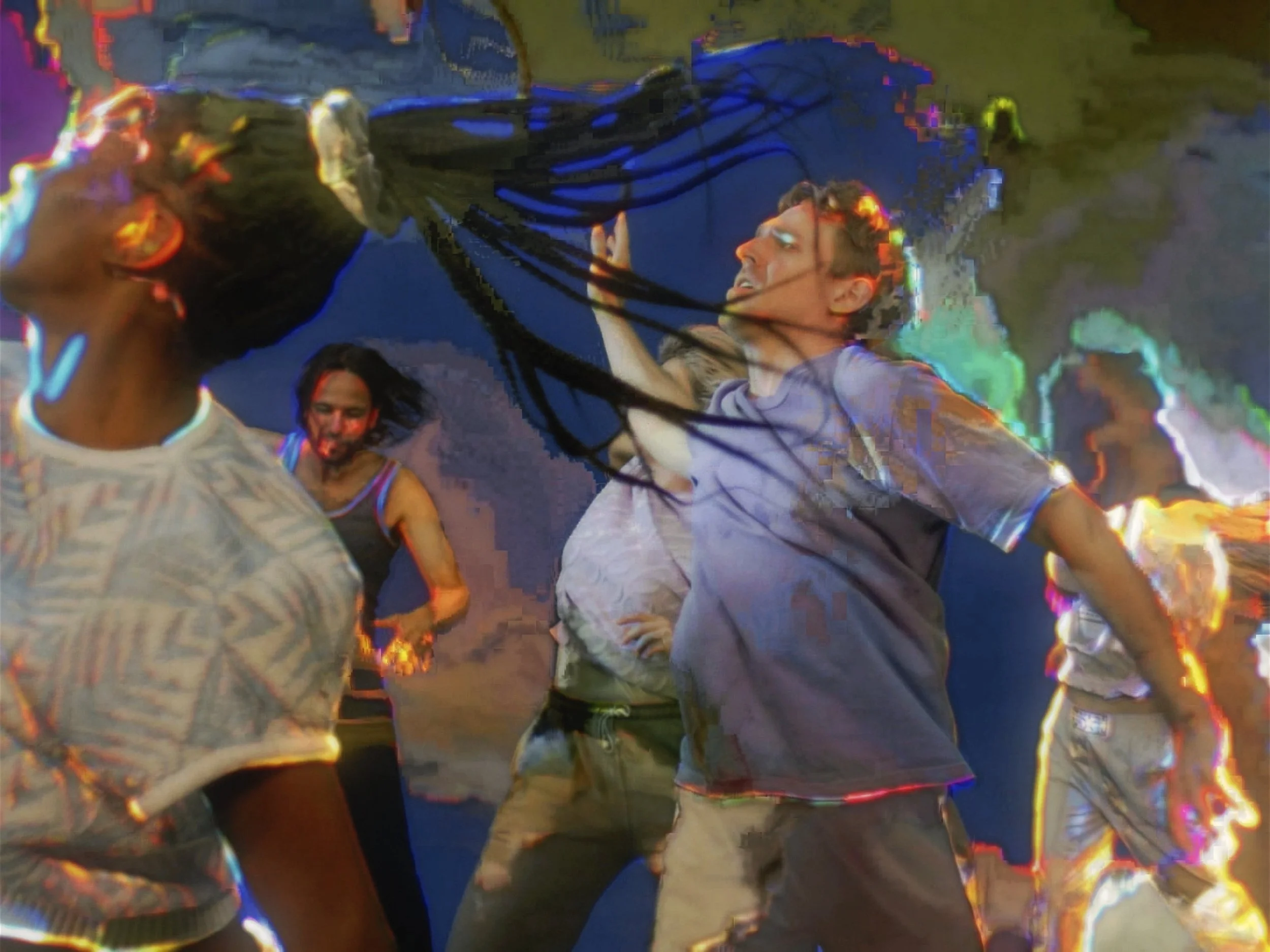Stir Q&A: Artist Jeremy Shaw talks about the time-bending, transcendent effects of Phase Shifting Index
Vancouver-raised, Berlin-based talent loves that the Polygon Gallery installation “triggers something strong enough in people that they feel compelled to act on it in public”
Jeremy Shaw, Phase Shifting Index, 2020, 7 channel video, sound and light installation. Installation view: Centre Pompidou, Paris. Photo by Timo
The Polygon Gallery presents Phase Shifting Index to September 24
WHEN WE SAY THAT viewing Vancouver-raised, Berlin-based artist Jeremy Shaw’s Phase Shifting Index is an experience, we mean that in the most visceral, mind-expanding, trippiest of ways.
At the seven-channel video, sound, and light installation making its North American premiere at the Polygon Gallery, each screen shows a group engaged in ritualistic movements—every mini pseudo-documentary feeling slightly sci-fi, but also retro in clothing (1960s to 1990s, including kitschy ‘80s exercise wear) and video quality (like Hi-8). While you take them in, a narrator describes the belief systems and the significance of movements like body-mind centring, popping-and-locking, hardcore punk skanking, and more.
And then something happens: cathartic rhythms synch up across the screens, warping any sense of time and space, before things unravel, glitch, and abstract into something else altogether. Without giving too much away, that ecstatic climax and chaos eventually lead you to a place that can only be described as cosmic calm.
It’s a remarkable work by a remarkable artist—one who has long explored altered states, transcendence, and scientific practices, primarily through video and photography.
Contemporary-art fans will remember Shaw’s DMT (also installed at the Polygon, in 2004), in which he filmed subjects, in closeup, trying to describe the experience of the titular hallucinogenic drug; or the silkscreens of Cathartic Illustration, employing documentary images of people shaking and quivering in spiritual, somatic, or technological altered states in an equal mix of ecstasy and something close to horror.
Shaw’s work has shown at Paris’s Centre Pompidou (where Phase Shifting Index premiered in 2020), MoMA PS1, the Tate Modern, Schinkel Pavillon, and the Venice Biennale. Shaw has also won Canada’s esteemed Sobey Art Award and was artist-in-residence at L.A.’s Hammer Museum.
Stir had the opportunity to talk to the internationally in-demand artist about his North Vancouver roots, his life in Berlin, and the making of Phase Shifting Index—plus what he loves about watching people experience it.
First, which influences do you think you still carry from growing up in North Van, and then studying in the Vancouver scene? And how connected are you to this place today?
I grew up in North Van in the early/mid ‘90s and was in and around various subcultures of the time: skateboarding, rave, hardcore. That early involvement in periphery areas of society evolved into a deeper interest around their belief systems and those of society in general, which I continue to be fascinated by to this day. Studying art in Vancouver in the late ‘90s instilled a very critical aspect to my practice. At that time in the city, you were really held accountable for your work conceptually and constantly called on to unpack it––which was a very positive thing to be subject to at that point in my life.
-
How has living in Berlin for all these years shifted or shaped your practice?
Jeremy Shaw. Photo by Alex Debrabent
Living in Berlin, or more, being part of the art scene in Berlin, shifted my practice in that it seemed to alleviate a certain overdetermination of how I was thinking about making work in Vancouver. I feel like there was an element of caution that had developed over the years in Vancouver and Berlin freed me of this to an extent.
-
Like so much of your work—we’re thinking about DMT, Quickeners, Cathartic Illustration—Phase Shifting Index explores our human search for transcendental experience. What do you feel is at the core of your fascination?
At the core, it’s an interest in what I see as a universal, age-old, and seemingly inherent human aspiration towards some sort of escape from the physical, the temporal, and from a perceived reality towards the incredibly subjective notion of transcendence––for lack of a better, less nebulous term. This is a super wide-reaching investigation that spans from the experiential to the scientific with all stops in between.
-
Each of these seven channels looks like found footage from a different era—from black-and-white 16 millimetre to High-8. What’s your relationship with the past—would you say you’re nostalgic or obsessed with analogue forms, or is it more of a technological or aesthetic interest? Or all of that?
There are many thing at play here, but a major one is that I’m using outmoded media to capitalize on the viewer’s relationship to it. People generally feel familiar with outmoded forms of media and assume that they understand how it functions. Material resembling documentary on these formats is perceived as historically sound and generally not questioned. I find manipulating this presumed historicity of media to be a very disarming way of proposition––highlighting the vulnerability of memory and nostalgia. I do also have an aversion to the high resolutions of contemporary media formats. Their abundance of resolution has always felt off to me—somewhat beyond real––even from the very dawn of digital video. And as such, when I finally get around to employing contemporary media, it’s generally to present something traumatic or horrific—a rupture of effects that exploits the potential of this overload of information.
Although they aren’t actually the documentaries they at first seem to be, is it true that each of these films portrays ritual practices and dance forms that actually exist—although you’ve tweaked them to feel like something’s a bit off, or futuristic? Can you describe the process of casting and shooting them, but also what must have been some rigorous research that went into them?
The piece was primarily cast during a two-day open call in Berlin. The initial parameters of the narrative and the ideologies and movement styles of each group were roughly 40 percent conceived going into this. We then workshopped with each group for three days and then we shot. The visual framework was controlled by location, wardrobe, casting, and camera work, but within that, the actual delivery of the narrative was left largely at the mercy of what evolved during shooting. From there, the writing and editing process connected the original concepts with what transpired in that raw material. This ended up producing a lot of reverse-engineering, but what the viewer witnesses in the “documentary” footage has a large element of realism to it—the performers really do go to these depths, they’re just doing so while aware of a certain fictional set-up.
Jeremy Shaw, Phase Shifting Index, 2020, 7 channel video, sound and light installation. Courtesy of the artist and Macaulay & Co Fine Art.
Was there one particular shoot experience that stood out?
Not one shoot in particular, but the “ecstatic” section, in which each group starts to come undone just before they land in the choreographed “sync” section, was always the most intense and fun to shoot. Myself and the choreographers, Justin Francis Kennedy and Emma Howes, would often be right in the mix as part of the group during these scenes, just off-camera and engaged in the same chaos as the dancers. The energy on the set during these scenes was incredible and I had an amazingly bizarre time directing from this place in between abandon and control—getting totally lost in the moment with the dancers and then pulling back out to continue directing. It was a kind of embodiment of the ‘affect-and-analysis’ element that I’ve pushed in earlier works.
You’ve clearly also always had a fascination with dance—Best Minds, Part One, with the hardcore kids’ cathartic dancing slowed down, or the dance-induced transcendence in Liminals. For Phase Shifting Index, how much was “choreographed”?
It varies with each of the seven films. Some have a lot of quite formal and rehearsed choreography, especially in the case when they are using more codified and technical forms, whereas others were almost entirely improvised, albeit always within certain parameters of style or form. The trans-temporal group sync moment was, of course, entirely choreographed so that each group lands in the identical dance routine keeping identical time.
You play a lot with the idea of time, and past and present morph and meld here in ways that are disorienting and exhilarating. What were you after in developing that kind of past-is-future feeling in Phase Shifting Index?
I’m very excited by the idea of non-linear time and parallel realities, and have been attempting to capture such a feeling without explicitly referring to it. I find that there is a wonderfully frustrating cognitive dissonance that is elicited when blurring timelines and combining paradoxical, out-of-time elements in a sort of deadpan or unassuming way. It’s a collapsed temporal space full of contradictory elements that aspires to uphold a suspension of disbelief but that is also relying on the viewer’s desire for this–– I’ve always felt like you kind of have to want to go there, that you have to be in on it in order for it to properly function.
Jeremy Shaw, Phase Shifting Index, 2020, 7 channel video, sound and light installation. Installation view: Centre Pompidou, Paris. Photo byTimo
Have viewers at Centre Pompidou and elsewhere described having their own kind of transcendent “trip” watching this—and was that the intent from the beginning?
The work was definitely engineered in an attempt to lure a subjective audience into an experience in which their autonomy is challenged and may eventually be consumed by affect. People often send me videos they have shot of random people interacting with the work; dancing through it, making out in it, attempting to join the synchronized climax. I absolutely love seeing this. I love that it triggers something strong enough in people that they feel compelled to act on it in public.
-
Phase Shifting Index devolves, or unravels, into something chaotic, but then you take it to a level that I would describe as cosmic. Not to get too deep here, but is there a higher power—a transcendence to aspire to? And where do you sit on the spirituality-versus-science spectrum?
I certainly believe that there is more than what we experience in our perceived versions of reality––likely infinite variations of infinite realities––but I generally pass on speculating as to what or how or how come. In general, I’m a skeptical believer in all of it.
















